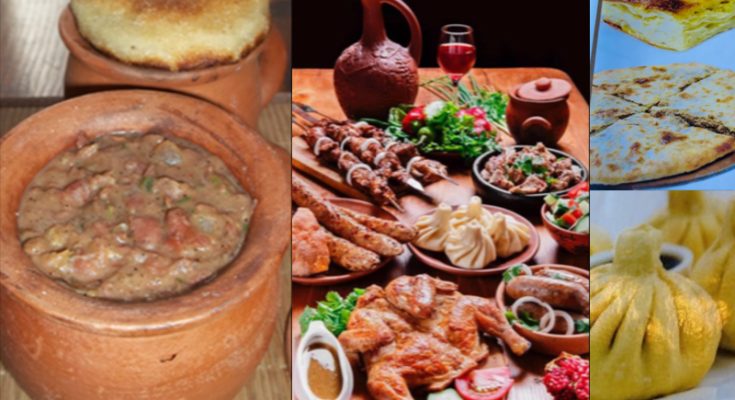#Georgianflavour, #food, #Delhi
IBNS: Georgia is only five hours away by flight from Delhi but we know precious little about this multifaceted country, especially its rich cuisine. Anju Munshi gives a lowdown on its gastronomic tradition fresh from a recent visit to capital Tbilisi
What is a place without its signature cuisine, as any veteran traveller would ask. A recent visit to Georgia’s capital Tbilisi, nestled between neighbour Azerbaijan and Armenia, introduced me to the country’s rich culinary tradition that has borrowed different flavours from the countries around.
Tbilisi’s cobbled walkways, long winded narrow alleys and paths punctuated with small cafes and eating outlets spring a surprise to people on their first visit there. An element of romance and mystery, especially when you handle your chopsticks and cutlery to attack the unfamiliar platter you eventually surrender to complete gastronomic bliss.
Georgia has a long and a rich history which was ruled by Persia (Iran) and Russian at different times. The cuisine reflects their influences.
The most popular Georgian foods are a large meat dumpling called khinkali and flatbread called kachapuri. They are always accompanied by fresh salad and a mild cheese called suluguni. It’s a non-curry cuisine with khachapuri as a queen dish .No feast is ever complete without it and is a Georgian classic. It looks like a covered pizza with suluguni cheese inside, nothing on top. Simply delicious. The filling could also vary from cheese to spinach ,red beans or mushrooms. There is also this boat-shaped khachapuri with an egg in the middle which is worth indulging in.

Kachapuri flatbreads, simple but yummy, are sold in every market. “They are a kind of pie filled usually with cheese. They can also be filled with meat, mushrooms, spinach or beans called lobiani. The heaviest one is filled with cheese and a half- raw egg and butter on top,” says Giorgi Sutiashvili, an expert at oil and gas industry in Georgia, and who has now forayed into production and marketing of ready- to-drink teas and other variants of the beverage in Georgia
Khinkalis are soup dumplings that you hook with a fork, bite a corner, slurp and finish the soup and then enjoy the dumplings with no fear of splattering the liquid. “The origins of khinkalis are disputed,” says Jamie Gwapo, a keen traveller who loves visiting Tbilisi. “I think it was introduced by the Mongols who brought it from China, but the people of Tbilisi strongly defend its origins in Georgia.”
Gwapo also adds that the cuisine carries some influences from other Caucasian, eastern European countries. “Flavours from the Mediterranean, as well as Turkey and the Middle East do interact with the local flavours making them detectable.”
Eggplants with walnut paste, fried mushrooms stuffed with salguni cheese, Lobiani beans served in clay pots, with cornbread are other regular items on the Georgian platter. Kharcho, stewed beef with a walnut tomato base and Mtsvadi a traditional Georgian barbecue, tease the taste buds instantly. A skewer of meat, chicken, lamb or pork marks for true celebration too.
The Georgian cheese platter with suluguni, smoked suluguni and gouda is a perfect accompaniment with a glass of wine..

Not to forget the Tonis bread , a sticky dough slapped on the sides of the oven to come out as a fine smelling, highly aromatic crispy leavened bread and soft inside. Reminds us of our tandoor cooking.
Georgian food is prepared with different spices for the meals and even the sauces need spices. Ajika red and green are the popular sauces, says Tia Zedelashvili . Besides being a good khachapuri maker at home, she has a masters in chemistry, handles the wine business, especially the bottling and packaging part.
“These sauces contain garlic, coriander, tomato, fenugreek, sea salt, red bell pepper marigold, tarragon etc. There is berry and plum sauce to add a fruity touch to the meals,” she says.
khmeli-suneli is a wonderful ready to use spice mix containing ground coriander seed, celery cinnamon, cloves, saffron, red pepper, dried basil, dill and parsley, is a great way to enhance the flavours of a dish, be it meat, vegetables and even rice.
Their fenugreek seeds are somehow different from the Indian one, as they are not bitter. utskho suneli meaning blue fenugreek finds its way in most of the recipes along with summer savoury, a herb that is delicately flavoured like mint leaves.

The salts are different as well. The megrelian salt is different from samagrelo salt, which is much stronger than the svenetian and megrelian salts put together . They are named after the regions they come from in Georgia.
Audich Samsy, Russian by birth but working as a doctor in Georgia, finds Georgian food spicier. “In fact, in Russia you just put garlic, dill and a bit of salt. Pepper used to be as expensive as gold not so long ago, we aren’t used to eating it,” he says.
Hemant Zakir from Dhaka who has business interests in Georgia says that he loves the cuisine as he loves walnuts and some of his favourite dishes are made with walnut paste or walnut sauce. “It’s healthy as well. Their menus are well balanced .Meats are balanced with a good amount of salads and vegetables, fruits and herbs.”
The dessert is not an intrinsic part of Georgian meals. In fact, fruit pulp is dried with nuts. It makes a nice nibble and can be had as a dessert or a snack as well.
The dried and the hanging strings of nuts and fruit pulp is called churchkhela and the flattened ones, called Tklapi.

Georgia is supposed to be the oldest wine producing region in the world. The fertile valleys and protective slopes of the South Caucasus were home to grapevines. After pressing the grapes and the juice is poured into the Qvevri, an egg shaped earthen pot which is sealed and buried in the ground so that the wine can ferment for five to six months before being drunk.
A well-known hospitality protocol of the Georgians is to ‘bolo mde’ meaning top up the glass as soon as it’s empty.
Not to forget a famous Georgian proverb that ‘Every guest is a gift from God’, somewhat in tandem with the Indian philosophy of hospitality atiithi devo bhavo.





